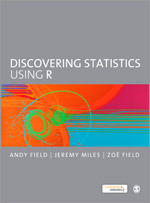Discovering Statistics Using R
- Andy Field - University of Sussex, UK
- Jeremy Miles - RAND Corporation, USA
- Zoë Field - University of Sussex, UK
Keeping the uniquely humorous and self-deprecating style that has made students across the world fall in love with Andy Field's books, Discovering Statistics Using R takes students on a journey of statistical discovery using R, a free, flexible and dynamically changing software tool for data analysis that is becoming increasingly popular across the social and behavioural sciences throughout the world.
The journey begins by explaining basic statistical and research concepts before a guided tour of the R software environment. Next you discover the importance of exploring and graphing data, before moving onto statistical tests that are the foundations of the rest of the book (for example correlation and regression). You will then stride confidently into intermediate level analyses such as ANOVA, before ending your journey with advanced techniques such as MANOVA and multilevel models. Although there is enough theory to help you gain the necessary conceptual understanding of what you're doing, the emphasis is on applying what you learn to playful and real-world examples that should make the experience more fun than you might expect.
Like its sister textbooks, Discovering Statistics Using R is written in an irreverent style and follows the same ground-breaking structure and pedagogical approach. The core material is augmented by a cast of characters to help the reader on their way, together with hundreds of examples, self-assessment tests to consolidate knowledge, and additional website material for those wanting to learn more.
Given this book's accessibility, fun spirit, and use of bizarre real-world research it should be essential for anyone wanting to learn about statistics using the freely-available R software.
Supplements
This is a fantastic book. Abdy field covers R in the same indepth and easy to understand manner as he does SPSS. I'm currently waiting to see if R catches on as an SPSS alternative ( Iexpect it will). A few of my students have used it on projects and this book has been a useful teaching aid.
This is a very good book to start for those who have a good foundation in statistic and have experience using statistical software. However it is not suitable for the undergraduate level at the department as for now since this will be the first time for the students to use statistical software. Other than that, it is quite expansive for students in this country.
Easy for students to understand
This book by Andy Field is very informative yet very readable.
I recommend it to students (regardless of whether they're working with R) as the ultimate up-to-date "statistics Bible". I have learnt and will continue to learn many things about statistics from its roughly 1000 pages, and I definitely will keep on recommending it to students.
The book is also very clever in information handling, very visual, and makes much use of different kinds of "boxes" that contain additional information. Its informal yet informative style is very intriguing.
Field is an excellent writer that can make abstract statistical techniques clear for just about any audience. However, for an undergraduate mass communication research course, not even Field can simplify the R statistical package. R is just too complex a program for undergrads in mass communication. So, excellent book. Great for other disciplines and graduate students in mass comm. Not so good for undergrads in mass comm.
Not for this semester. Plan to use it next fall
This book is marvelous! Just like the one Field has published based on SPSS. It guides students through statistics, provides basic applications but is also very useful for advanced students and researchers. And - in contrast to the "Discovering Statistics using SPSS" - it has been written for using the fabolous (!) free R. Applause for Mr. Field!!!
This is a Master level rather than UG course book. But if I were to teach an MA course I would recommend if not make essential reading
A wonderful resource for anyone using SPSS in their statistical research.
Recommended for anyone conducting statistical research scross all relevant programmes
Very good book
written in a readable style









